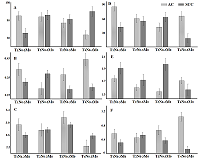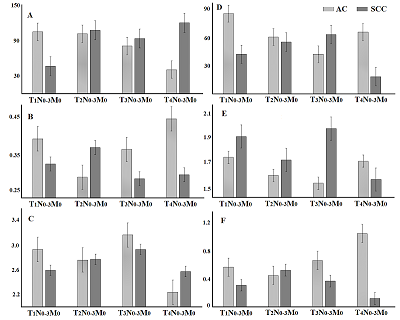Antioxidant Protection System in the Saliva of Patients with Non-Small Cell Lung Cancer
1Omsk State Pedagogical University, 14 Tukhachevsky str., Omsk, 644043 Russia; *e-mail: Ludab2005@mail.ru
2Omsk State Medical University, 12 Lenina str., Omsk, 644099, Russian Federation
3Strasbourg University Hospital, Strasbourg, 67091 France
Keywords: saliva; non-small cell lung cancer; antioxidant protection
DOI:10.18097/BMCRM00061
The purpose of the study was to study parameters of the antioxidant protection system in saliva for non-small cell lung cancer. In the case-control study, included 683 volunteers, which were divided into 3 groups: primary (lung cancer patients, n = 290), comparison group (patients with non-malignant pulmonary pathologies, n = 178) and control (conditionally healthy individuals, n = 215). Biochemical examination of saliva, histological verification of the diagnosis were carried out for all participants. The parameters of the antioxidant defense was determined spectrophotometrically. Intergroup differences were estimated by a nonparametric criterion. Saliva of lung cancer patients was characterized by imbalance in the antioxidant defense. It is shown that the activity of the enzymes of the first link of antioxidant protection (catalase, SOD) was significantly reduced (p ˂ 0.0001), whereas activity of salivary peroxidases increase (p = 0.0037). The parameters of non-enzymatic protection varied in opposite directions: the level of uric acid in lung pathologies decreases (p = 0.0399), whereas albumin concentration increased, under these conditions, it begins to exhibit pro-oxidant properties. Differences between adenocarcinoma and squamous cell lung cancer have been found in terms of the mode of the dynamics of antioxidant protection parameters. Probably, against the background of squamous cell lung cancer, an enzymatic link (catalase, SOD) contributes to the antioxidant protection system, whereas against adenocarcinoma - nonenzymatic (uric acid, albumin).
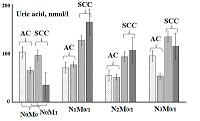
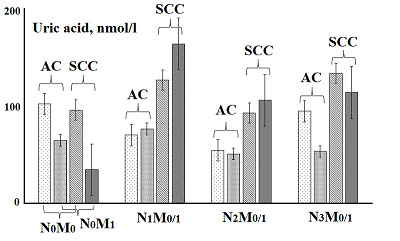
|
Figure 2.
Dynamics of uric acid concentration depending on the presence/absence of distant and regional metastasis.
|
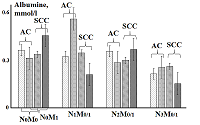
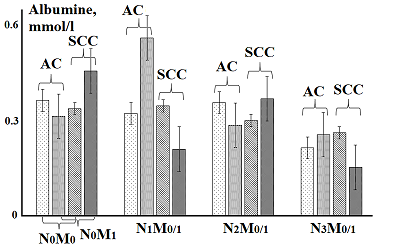
|
Figure 3.
Dynamics of albumin concentration depending on the presence/absence of distant and regional metastasis.
|
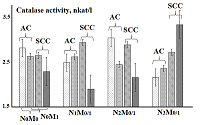
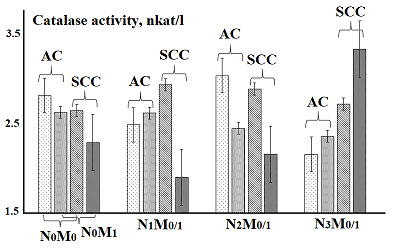
|
Figure 4.
Dynamics of catalase activity depending on the presence/absence of distant and regional metastasis.
|
|
CLOSE

|
Table 1.
Indicators of antioxidant protection in the saliva.
|
|
CLOSE

|
Table 2.
System of antioxidant protection of saliva in lung cancer of different histological types.
|
|
CLOSE

|
Table 3.
Indicators of antioxidant protection in the presence/absence of distant metastasis.
|
REFERENCES
- Liou, G-Y. & Storz, P. (2010) Reactive oxygen species in cancer. Free Radic. Res., 44(5), 479-496. DOI
- Bedard, K. & Krause, K.H. (2007) The NOX family of ROS-generating NADPH oxidases: physiology and pathophysiology. Physiol. Rev., 87(1), 245–313. DOI
- Schieber, M. & Chandel, N. (2014) ROS function in redox signaling and oxidative stress. Curr. Biol., 24(10), R453–462. DOI
- Liu, Y., Fiskum, G. & Schubert, D. (2002) Generation of reactive oxygen species by the mitochondrial electron transport chain, J. Neurochem., 80(5), 780–787.
- Robinson, J.M. (2008) Reactive oxygen species in phagocytic leukocytes. Histochem. Cell Biol., 130(2), 281–297. DOI
- Richter, K., Konzack, A., Pihlajaniemi, T., Heljasvaara, R. & Kietzmann, T. (2015) Redox fibrosis: impact of TGFbeta1 on ROS generators, mediators and functional consequences. Redox Biology, 6, 344–352. DOI
- Morry, J., Ngamcherdtrakul, W. & Yantasee, W. (2017) Oxidative stress in cancer and fibrosis: Opportunity for therapeutic intervention with antioxidant compounds, enzymes, and nanoparticles. Redox Biology, 11, 240–253. DOI
- Nikolayev, I.V., Kolobkova, L.N., Landesman, E.O., Stepanova, E.V. & Koroleva, O.V. (2008) The antioxidant and peroxidase activities of saliva in patients with inflammatory periodontal diseases and possibility of their correction. Biochem. Moscow Suppl. Ser. B, 2, 426. DOI
- Khan, A., Tania, M., Zhang, D. & Chen, H. (2010) Antioxidant Enzymes and Cancer. Chin J Cancer Res., 22(2), 87–92. DOI
- Abiaka, C., Al-Awadi, F., Al-Sayer, H., Gulshan, S., Behbehani, A. & Farghally, M. (2002) Activities of Erythrocyte Antioxidant Enzymes in Cancer Patients. Journal of Clinical Laboratory Analysis, 16, 167–171. DOI
- Chanchayeva, E.A., Ayzman, R.I. & Gerasev, A.D. (2013) Modern idea of the antioxidant system of the human body. Ekologiya Cheloveka, 7, 50–58.
- Sozarukova, M.M., Proskurina, E.V. & Vladimirov, Yu.A. (2016) Serum albumin as a source and 'target of free radicals in pathology. Vestnik RGMU, 1, 61–67.
- Östürk, L.K., Akyüz, S., Yarat, A., Koç, S., Gül, N. & Doğan, B.N. (2010) Salivary lipid peroxidation and total sialic acid levels during healthy gestation and postpartum: a longitudinal study. Clinical Biochemistry, 43, 430–434. DOI
- Wong, D.T. Salivary Diagnostics. Wiley-Blackwell; 2008; 320 p.
- Giebutowicz, J., Wroczynski, P. & Samolczyk-Wanyura, D. (2011) Comparison of antioxidant enzymes activity and the concentration of uric acid in the saliva of patients with oral cavity cancer, odontogenic cysts and healthy subjects. J Oral Pathol Med., 40, 726–730. DOI
- Miller, C.S., Foley, J.D., Bailey, A.L., Campell, C.L., Humphries, R.L., Christodoulides, N., Floriano, P.N., Simmons, G., Bhagwandin, B., Jacobson, J.W., Redding, S.W., Ebersole, J.L. & McDevitt, J.T. (2010) Current developments in salivary diagnostics. Biomark Med.,4(1), 171–189.
- SSoares Nunes, L.A., Mussavira, S., Bindhu, O.S. (2015) Clinical and diagnostic utility of saliva as a non-invasive diagnostic fluid: a systematic review. Biochemia Medica, 25(2), 177–192. DOI
- Arunkumar, S., Arunkumar, J.S., Krishna, N.B. & Shakunthala, G.K. (2014) Developments in diagnostic applications of saliva in oral and systemic diseases - A comprehensive review. Journal of Scientific and Innovative Research, 3(3), 372-387.
- Clinical biochemistry. Collection of instructions. Novosibirsk: ZAO «Vektor-Best». 2011. 132 s.
- Sirota, T.V. (2015) Involvement of carbonate / bicarbonate ions in the superoxide of the generating reaction of autooxidation of adrenaline. Biomeditsinskaya khimiya, 61(1), 115–124. DOI
- Korolyuk, M.A., Ivanova, L.I., Mayorova, I.G. & Tokarev, V.E. (1988) Method for the determination of catalase activity. Laboratornoye Delo, 1, 16–19.
- Kondrakhin, I.P. Methods of veterinary clinical laboratory diagnostics: a reference book. M.: Kolos, 2004. 520 s.
- Bel'skaya, L.V., Sarf, E.A., Kosenok, V.K. & Massard, Zh. (2017) The antioxidant activity of mixed human saliva is normal. Ekologiya cheloveka, 6, 36–40.
- Sidorenko, Yu.S., Balyazin-Parfenov, I.V., Frantsiyants, E.M., Komarova, E.F., Pogorelova, Yu.A. & Cheryarina, N.D. (2011) Evaluation of the dynamics of free radical processes in brain tumors and metastases of cancer of various localizations in the brain. Sovremennyye tekhnologii v meditsine, 2, 42–46.
- Dubinina, E.E. (2001) The Role of Active Oxygen Forms as Signal Molecules in the Metabolism of Tissues in Oxidative Stress. Voprosy Meditsinskoy Khimii, 47(6), 561–581.
